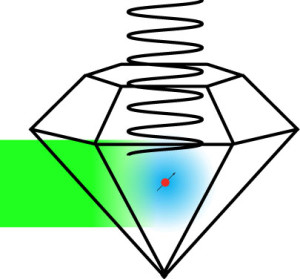Diamonds Increase Sensitivity of NMR and MRI

Researchers from the U.S. Department of Energy (DOE)’s Lawrence Berkeley National Laboratory (Berkeley Lab) and the University of California (UC) Berkeley have hyperpolarized carbon-13 nuclei in diamonds at room temperature and using microwaves. The signal of the hyperpolarized spins showed a nuclear magnetic resonance (NMR)/magnetic resonance imaging (MRI) signal several times higher than the one obtained by standard magnetic resonance methods. The findings were published in Nature Communications.
Nuclear magnetic resonance spectroscopy is a highly specific, non-invasive structural and imaging technique used in fields like material science, organic chemistry or biophysics. The main limitation of NMR/MRI is its limited sensitivity. Matter is composed of atoms whose nuclei have a specific spin (up/down), a quantum property that makes them act like magnets. When exposed to a magnetic field, spins align accordingly. The greater the net alignment, the stronger the signal. Professor Pines lab has been working for a long time on finding new ways of hyperpolarizing nuclei to increase the technique’s sensitivity. One of such tests was carried out in diamond; specifically, on diamond impurities called nitrogen-vacancy (NV) centers, where unbound electrons generate singular spin-polarization states. These electron spin polarization can be transferred to nuclei nearby, and in a recent study, the Pines’ lab used this dynamic nuclear polarization method to hyperpolarize carbon-13 nuclei in a diamond. However, the polarization transference needed cryogenic temperatures and a strong magnetic field.
Hyperpolarization of carbon-13 nuclei at room temperature
In the new study, led by Pines lab member Jonathan King, the researchers were able to transfer the diamond’s electron spin polarization to carbon-13 nuclei at room temperature. Instead of specific magnetic fields, the polarization transfer was achieved with microwaves. These conditions make experiments easier to carry out, and eliminate restrictions in the strength and alignment of the magnetic field. The bulk sample can now be directly measured with NMR.
The new hyperpolarization transfer technique, together with the construction of devices with large diamond surfaces, could generate a widespread use, in NMR labs around the world, of diamond NV centers to transfer polarization to liquid and solid samples.
Source: Berkeley Lab

